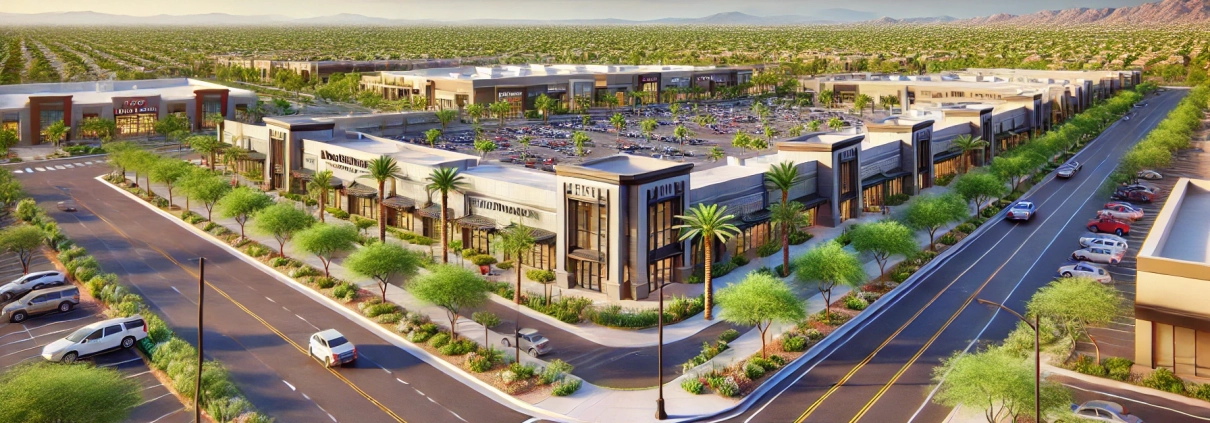Hard Costs
Any development costs associated with the physical construction of a building. These costs are easy to quantify and typically include items such as raw materials, labor, and interior finish, etc. Hard costs are also referred to as Direct Costs.
Putting ‘Hard Costs’ in Context
Sonoran Vista Development, a real estate development firm based in Arizona, is embarking on a ground-up development project for Palo Verde Plaza, a new 45,000-square-foot neighborhood shopping center located in Tucson, Arizona. The project is situated on a 6-acre site, strategically positioned at the intersection of two major roads to capture high traffic volume and visibility.
The Role of Hard Costs in Palo Verde Plaza’s Development
In this ground-up development, the hard costs—those directly tied to the physical construction of the property—are a critical component of the project budget. These costs are straightforward to quantify and include:
- Site Preparation: $1.2 million for grading, utility connections, and foundational work.
- Structural Construction: $6 million for raw materials like concrete, steel, and roofing, as well as the labor to build the structure.
- Interior Finish: $1.8 million for flooring, lighting, HVAC installation, and tenant build-outs.
- Landscaping and Parking: $800,000 for green spaces, parking lot paving, and external amenities.
The total estimated hard costs for Palo Verde Plaza are $9.8 million, accounting for approximately 65% of the overall project budget.
Example Calculation of Hard Costs per Square Foot
To analyze the efficiency of the development, Sonoran Vista Development calculated the hard costs on a per-square-foot basis. The formula is:
Hard Costs per Square Foot = Total Hard Costs / Total Gross Square Footage
$9,800,000 ÷ 45,000 = $217.78 per square foot
This figure provides a benchmark for evaluating construction efficiency against similar retail projects in Tucson and allows for more accurate financial forecasting.
Importance of Hard Costs
For a project like Palo Verde Plaza, managing hard costs effectively is vital to the development’s financial success. Rising material costs or unforeseen construction delays could inflate the budget, directly impacting the project’s feasibility. To mitigate these risks, Sonoran Vista Development locked in prices with suppliers early and ensured rigorous oversight of labor costs and schedules.
Outcome
The inclusion of precise hard costs allowed Sonoran Vista Development to confidently secure financing for the project, meet lender requirements, and attract interest from prospective tenants. Anchored by a national grocery chain and several smaller retail tenants, Palo Verde Plaza is expected to generate a stabilized NOI of $1.4 million annually, yielding a healthy return for the developer.
Frequently Asked Questions about Hard Costs in Real Estate Development
What are “Hard Costs” in real estate development?
Hard Costs refer to “any development costs associated with the physical construction of a building.” These include items such as raw materials, labor, and interior finish. They are also known as Direct Costs and are typically easy to quantify.
What is included in Hard Costs?
Hard Costs typically include:
Site Preparation (e.g., grading, utility connections, foundational work)
Structural Construction (e.g., concrete, steel, roofing, and labor)
Interior Finish (e.g., flooring, lighting, HVAC, tenant build-outs)
Landscaping and Parking (e.g., green spaces, paving, external amenities)
How much were the Hard Costs for Palo Verde Plaza?
The total estimated hard costs for Palo Verde Plaza were $9.8 million, which accounted for approximately 65% of the overall project budget.
How are Hard Costs calculated on a per-square-foot basis?
The formula is:
Hard Costs per Square Foot = Total Hard Costs / Total Gross Square Footage
For Palo Verde Plaza:
$9,800,000 ÷ 45,000 sq ft = $217.78 per square foot
Why are Hard Costs important in real estate development?
Hard Costs are a critical component of the project budget and are vital to a development’s financial success. They impact construction efficiency, financing, and ROI. The blog notes:
“Rising material costs or unforeseen construction delays could inflate the budget, directly impacting the project’s feasibility.”
How did Sonoran Vista manage the risk of rising Hard Costs?
To mitigate risks, Sonoran Vista Development locked in prices with suppliers early and ensured rigorous oversight of labor costs and schedules.
What was the financial outcome of managing Hard Costs effectively?
Precise management of hard costs helped Sonoran Vista Development secure financing, meet lender requirements, and attract tenants. The project is expected to generate a stabilized NOI of $1.4 million annually, ensuring a healthy return for the developer.
What is the size and location of the Palo Verde Plaza project?
Palo Verde Plaza is a 45,000-square-foot neighborhood shopping center located in Tucson, Arizona, on a 6-acre site at the intersection of two major roads to ensure high traffic and visibility.
Who are the tenants of Palo Verde Plaza?
Palo Verde Plaza is anchored by a national grocery chain along with several smaller retail tenants, helping to ensure occupancy and return stability.
Click here to get this CRE Glossary in an eBook (PDF) format.

